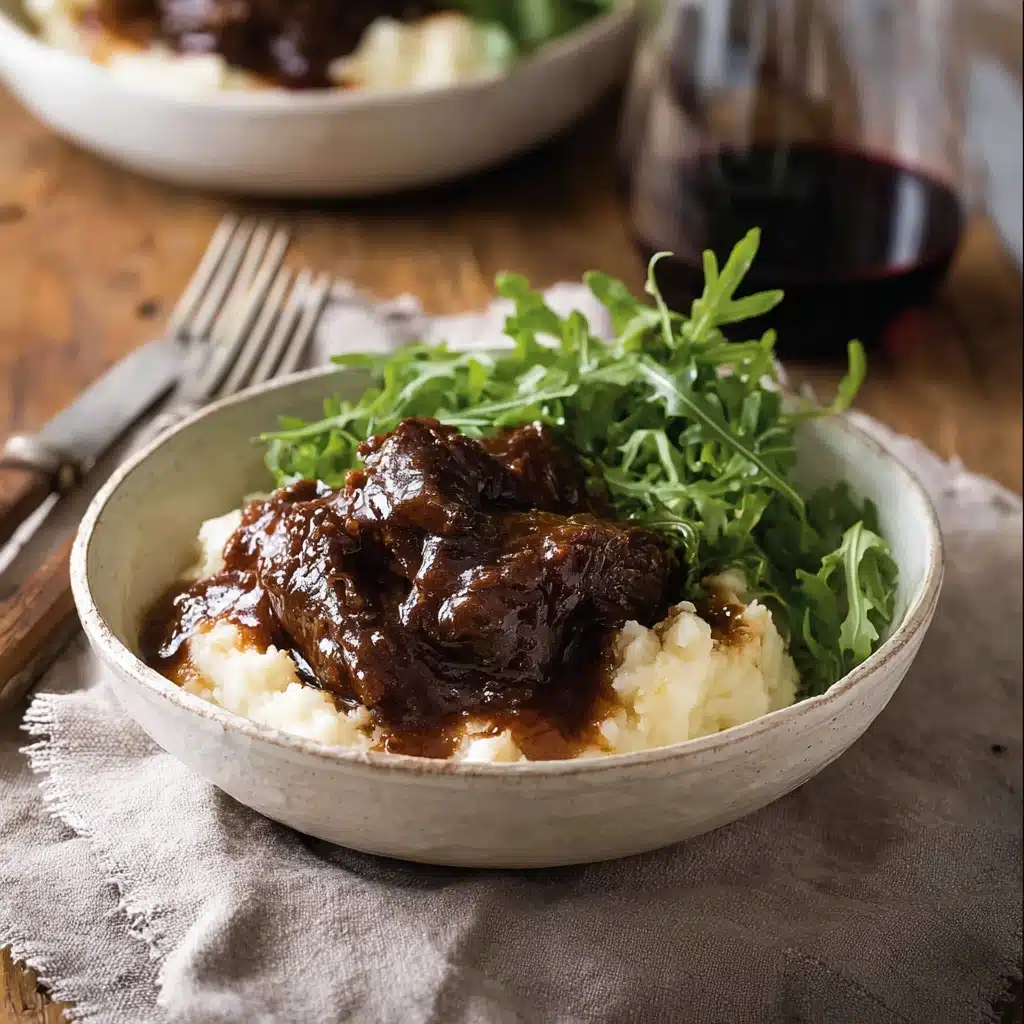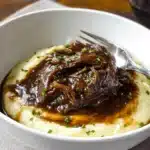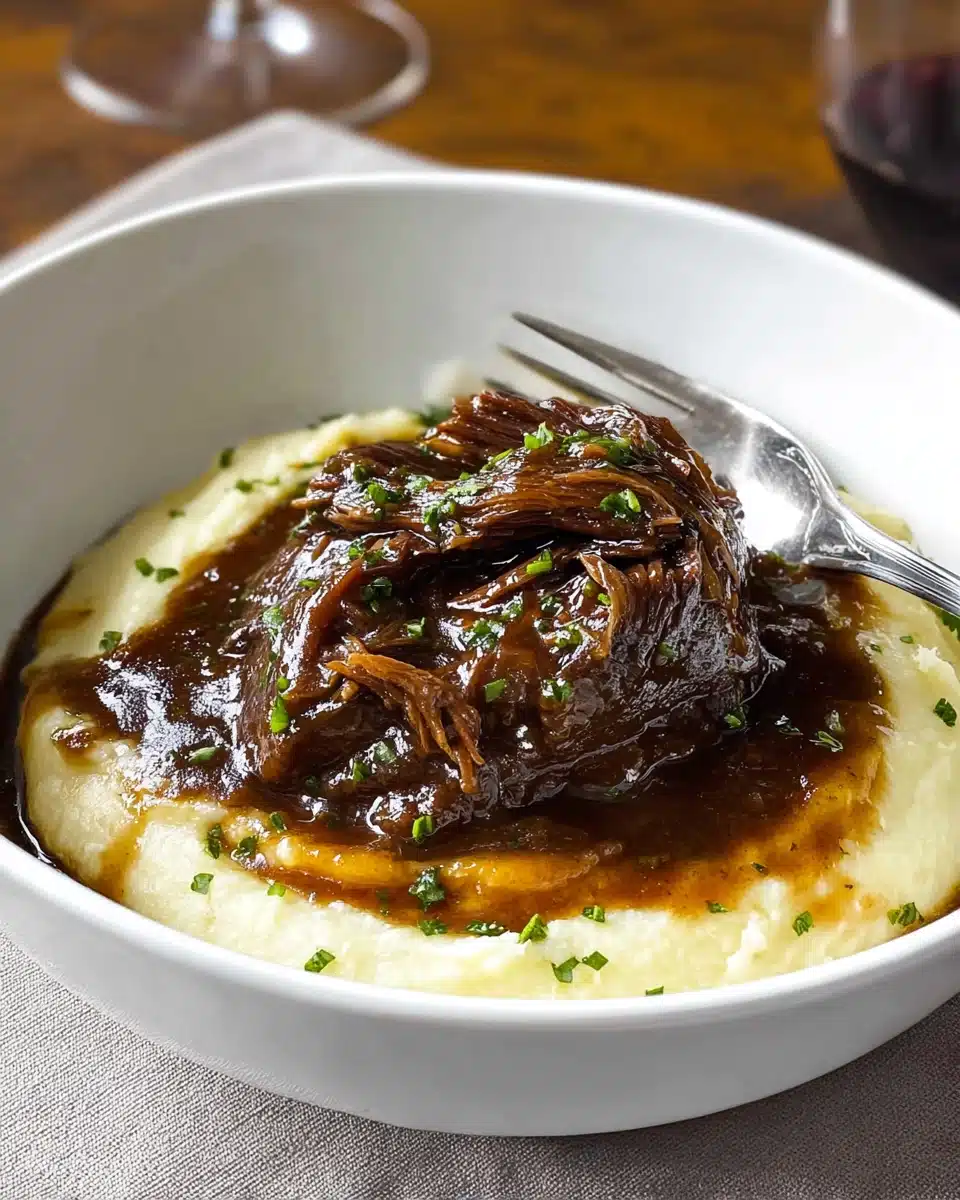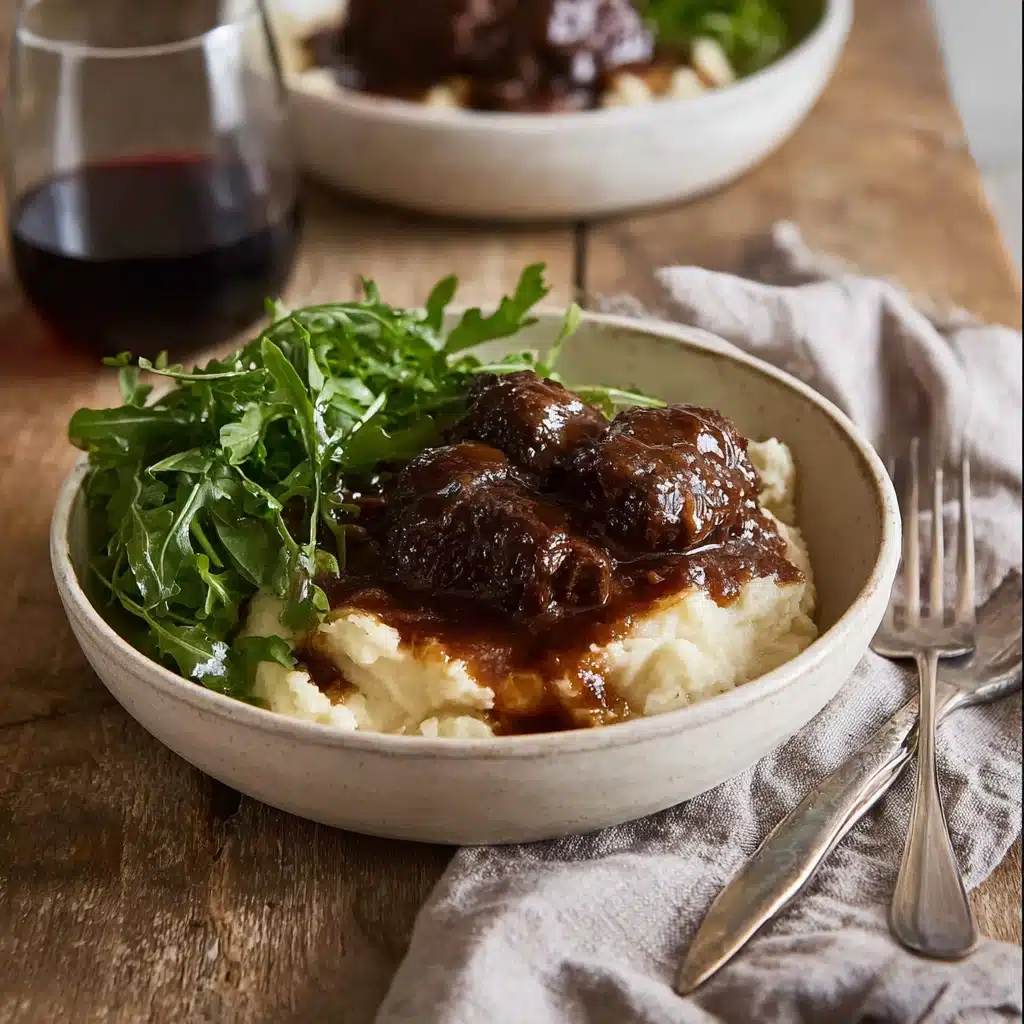If you’ve ever dreamed of a rich, melt-in-your-mouth dinner that feels like a warm hug on a chilly evening, Slow Cooked Beef Cheeks in Red Wine Sauce will sweep you off your feet. This dish transforms humble ingredients into a show-stopping meal—the beef cheeks become buttery soft after hours of gentle simmering, soaking up all the deep, velvety flavors of red wine, herbs, and vegetables. Whether you’re serving a cozy family dinner or making a lasting impression at a dinner party, this recipe is pure comfort laced with elegance. Let’s dive right in and make this magic happen in your kitchen!
Ingredients You’ll Need
The ingredient list for Slow Cooked Beef Cheeks in Red Wine Sauce is refreshingly straightforward, but each component has a vital role in building layers of hearty flavor, incredible texture, and vibrant color. Don’t be tempted to skip or skimp—these are the building blocks of pure comfort!
- Beef cheeks: The star of the dish—slow cooking transforms these into irresistible, fork-tender bites.
- Red wine: Use a bold, good-quality dry red wine—it creates a deep, rich sauce that’s packed with complexity.
- Beef stock: Boosts the savoriness and ensures the sauce is rich and full-bodied.
- Carrots: Add sweetness, color, and a soft texture after simmering for hours.
- Celery stalks: Bring earthy undertones to balance the sweetness and intensify the aroma.
- Onions: Give body, sweetness, and a silky texture to the sauce.
- Garlic cloves: Offer pungency and a savory depth essential to any great stew.
- Tomato paste: Adds tang and a deep red color that thickens and enriches the sauce.
- Fresh thyme: Lends a hint of herbal brightness that cuts through the richness.
- Bay leaves: Create a subtle, aromatic backbone for the sauce.
- Olive oil: For browning and unlocking all the savory flavors from the ingredients.
- Salt and pepper: The non-negotiables for lifting and balancing every other flavor.
- Flour: A light dusting for the beef cheeks helps them brown beautifully and slightly thickens the sauce.
How to Make Slow Cooked Beef Cheeks in Red Wine Sauce
Step 1: Prepare the Beef Cheeks
Trim any excess fat and sinew from the beef cheeks to ensure you’re left with pure, melty meat. Pat them dry with paper towels, then season generously with salt and pepper all over. Sprinkle a light dusting of flour, just enough to help with browning and to lend body to your finished sauce.
Step 2: Sear the Beef Cheeks
Heat olive oil in a large Dutch oven or heavy-bottomed pot over medium-high heat. Sear the cheeks for about 3-4 minutes on each side until they develop a gorgeous, caramelized crust. This step creates essential layers of flavor—don’t rush it, and savor the sizzle!
Step 3: Sauté the Aromatics
Transfer the browned beef cheeks to a plate. In the same pot, add a bit more olive oil if needed, and toss in the chopped onions, carrots, celery, and garlic. Sauté for 5–7 minutes until the vegetables soften and release their sweetness, scraping up any browned bits. This is where the magic builds up!
Step 4: Build the Sauce
Stir in the tomato paste and cook for a minute or two until it darkens. Pour in the red wine, stirring to deglaze the pot and lift all that delicious caramelization off the bottom. Simmer for a few minutes to let the alcohol cook off, then add the beef stock, thyme, and bay leaves.
Step 5: Slow Cook to Perfection
Nestle the beef cheeks back into the sauce, making sure they’re partially submerged. Bring to a gentle simmer, cover, and let everything cook low and slow—either in a 160°C (320°F) oven or on the stovetop—for about 3–3.5 hours. By the end, the beef cheeks will be spoon-tender and the red wine sauce deeply glossy and rich.
Step 6: Finishing Touches
Carefully remove the beef cheeks and set them aside. Skim off any excess fat from the surface of the sauce, and if you prefer a smoother texture, blend the vegetables into the sauce with an immersion blender. Return the cheeks, spoon sauce over them, and simmer gently for 10 minutes to bring everything together beautifully.
How to Serve Slow Cooked Beef Cheeks in Red Wine Sauce

Garnishes
A sprinkle of chopped fresh parsley or thyme elevates your Slow Cooked Beef Cheeks in Red Wine Sauce with a burst of color and freshness, perfectly countering the rich sauce. For a special touch, add lemon zest or a swirl of crème fraîche right before serving.
Side Dishes
Comforting sides shine here—bedding the beef cheeks atop creamy mashed potatoes or buttery polenta is pure heaven. Warm, crusty bread is another must for soaking up every last drop of the luxurious sauce. Roasted root vegetables or garlicky green beans round things out beautifully.
Creative Ways to Present
For guests, try serving Slow Cooked Beef Cheeks in Red Wine Sauce in individual shallow bowls for a restaurant-style vibe. Or pile it family-style in a large casserole dish, letting everyone dig in. You can also pull the beef apart and spoon it over homemade pasta or creamy risotto for a stunning twist.
Make Ahead and Storage
Storing Leftovers
Cool leftovers completely, then transfer them to an airtight container in the fridge. Slow Cooked Beef Cheeks in Red Wine Sauce actually tastes even better the next day as the flavors continue to meld and deepen!
Freezing
This dish freezes like a dream. Divide into portions, place in sealed containers, and freeze for up to 3 months. Be sure to leave a little space in the container, as the sauce will expand slightly as it freezes.
Reheating
Simply thaw overnight in the fridge if frozen, then gently reheat on the stovetop over low heat, stirring occasionally until piping hot. Add a splash of beef stock or water if the sauce needs loosening. The beef will remain sumptuously tender.
FAQs
Can I make Slow Cooked Beef Cheeks in Red Wine Sauce in a slow cooker?
Absolutely! After browning the beef cheeks and sautéing the vegetables, transfer everything to the slow cooker. Cook on low for 8 hours or until the cheeks are melt-in-your-mouth tender.
What if I can’t find beef cheeks?
If beef cheeks are hard to find, you can substitute with beef shank, short ribs, or even chuck roast. While nothing quite matches the texture of beef cheeks, these cuts will still give you a deliciously rich and tender result.
Does it matter which red wine I use?
A dry, full-bodied red wine like Cabernet Sauvignon, Shiraz, or Merlot is ideal. Choose a bottle you enjoy drinking, as the flavor will shine through in your Slow Cooked Beef Cheeks in Red Wine Sauce.
Can I make this dish ahead for a dinner party?
Yes! This recipe is perfect for make-ahead entertaining, since the flavors deepen overnight. Simply reheat gently and finish with your favorite garnish right before serving.
How do I thicken the sauce if it’s too thin?
If the red wine sauce is a little runny after cooking, simply simmer it uncovered for a few extra minutes to reduce, or stir in a cornstarch slurry (1 teaspoon cornstarch mixed with a splash of cold water) and cook until thickened.
Final Thoughts
If you’re ready for a truly memorable meal, give Slow Cooked Beef Cheeks in Red Wine Sauce a try. Trust me, one bite and you’ll see why it continues to win hearts (and spoons!) at every table. Happy cooking!
Print
Slow Cooked Beef Cheeks in Red Wine Sauce Recipe
- Prep Time: 20 minutes
- Cook Time: 8 hours
- Total Time: 8 hours 20 minutes
- Yield: 4 servings 1x
- Category: Main-course
- Method: Slow Cooking
- Cuisine: French
- Diet: Gluten Free
Description
Experience melt-in-your-mouth Slow Cooked Beef Cheeks in Red Wine Sauce—an indulgent, comforting main course inspired by classic French bistro flavors. Beef cheeks are gently braised for hours in a rich, aromatic red wine sauce with vegetables and herbs, resulting in a deeply savory dish that’s perfect for special dinners or cozy nights in.
Ingredients
For the Beef Cheeks
- 1.2 kg (about 2.5 lbs) beef cheeks, trimmed
- 1 tablespoon olive oil
- Salt and freshly ground black pepper, to taste
For the Red Wine Sauce
- 2 cups dry red wine
- 2 cups beef stock
- 1 large onion, finely chopped
- 2 carrots, peeled and chopped
- 2 celery stalks, chopped
- 4 garlic cloves, minced
- 2 tablespoons tomato paste
- 2 bay leaves
- 4 sprigs fresh thyme
- 2 sprigs fresh rosemary
To Finish
- 1 tablespoon unsalted butter (optional, for gloss)
- Fresh parsley, chopped, for garnish
Instructions
- Prep the Beef Cheeks: Pat beef cheeks dry with paper towels. Season all sides generously with salt and pepper.
- Sear the Beef: Heat olive oil in a large skillet over medium-high heat. Sear beef cheeks for 3–4 minutes per side until well-browned. Transfer to your slow cooker.
- Sauté the Vegetables: In the same skillet, add chopped onion, carrots, and celery. Sauté for 3–4 minutes until softened, then stir in the garlic and tomato paste. Cook for an additional minute until fragrant.
- Deglaze and Combine: Pour in the red wine and scrape up any browned bits. Let it simmer for 2–3 minutes before transferring the vegetable mixture and wine to the slow cooker. Add beef stock, bay leaves, thyme, and rosemary.
- Slow Cook: Stir gently to combine. Cover and cook on low for 8 hours, or on high for 5–6 hours, until the beef cheeks are fork-tender.
- Finish the Sauce: Remove beef cheeks and set aside covered. Discard herb stems and bay leaves. Skim off excess fat from the sauce. For a thicker sauce, transfer to a saucepan and simmer uncovered for 10–15 minutes to reduce, then stir in butter for extra gloss and richness if desired.
- Serve: Return the beef cheeks to the sauce or plate them and spoon over the sauce. Sprinkle with fresh parsley and serve hot, ideally with creamy mashed potatoes or polenta.
Notes
- If beef cheeks are unavailable, use brisket or chuck as substitutes (cooking time may vary).
- Choose a red wine that’s good enough to drink for best results (Cabernet Sauvignon or Shiraz work beautifully).
- This dish tastes even better the next day after flavors have melded.
- For best texture, trim excess fat and sinew from beef cheeks before cooking.
Nutrition
- Serving Size: 1/4 of recipe
- Calories: 480
- Sugar: 6g
- Sodium: 780mg
- Fat: 20g
- Saturated Fat: 8g
- Unsaturated Fat: 10g
- Trans Fat: 0.4g
- Carbohydrates: 12g
- Fiber: 2g
- Protein: 52g
- Cholesterol: 150mg




Your email address will not be published. Required fields are marked *